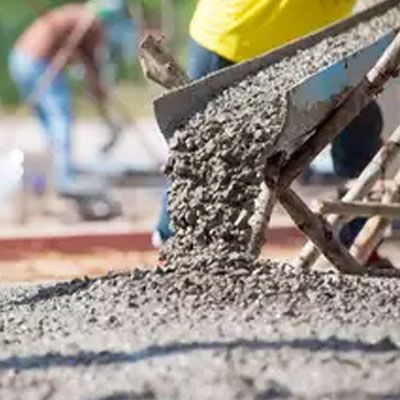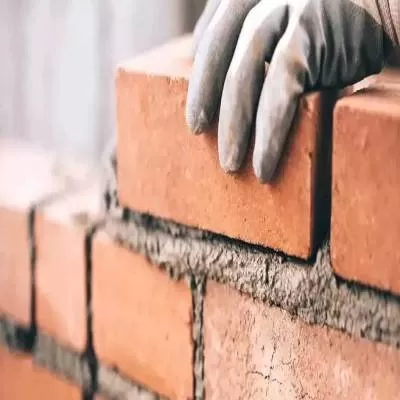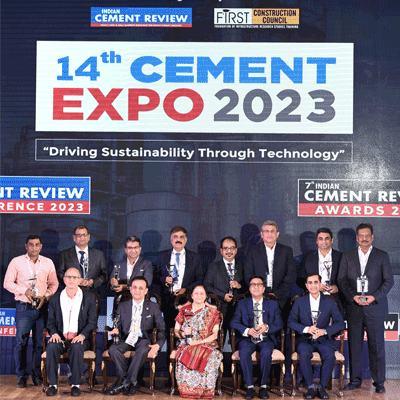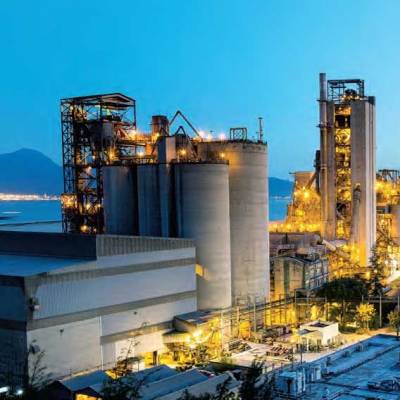- Home
- Building Material
- Cement
- Tech in Cement

Tech in Cement
Consumption has increased from 166 mt in 2011 to 249 mt last year. On the back of key growth drivers, demand is expected to grow to 398 mt by 2017 and to 600 mt by 2025.
What are these drivers?
´Restarting stalled infrastructure works like roads projects and metros in Tier-II cities, launching new infrastructure projects, reducing home loan interest rates and a drop in real estate prices will be the key drivers of cement demand in the near term,´ says K Swaminathan, Executive Director-Sales, Dalmia Cement (Bharat) Ltd.´We expect demand to marginally increase in the second half of the ongoing financial year.´
Missing in action: Plant drivers
So far, growing demand for cement hasn´t translated into enhanced demand for cement plants. Atonu Bhattacharya, Vice President (Marketing-Cement Division), ThyssenKrupp Industries India Pvt Ltd, explains why: ´India´s cement industry is operating at 70-75 per cent of its installed capacity.´
About 97 per cent of India´s installed cement capacity spans 188 large cement plants with a combined capacity of 358.9 mtpa. Of these, 77 are located in the states of Andhra Pradesh, Rajasthan and Tamil Nadu. Another 365 mini and white cement plants with an installed capacity of 11.1 mtpa complete the manufacturing facilities. Close to 70 per cent of India´s output comes from 20-odd leading cement companies. ´Until the economy turns around and, in particular, the construction sector picks up in India, the growth rate of the cement industry will be low,´adds Bhattacharya.
´Pressing ahead with key economic reforms, infrastructure projects and residential schemes in a major way would boost demand for cement plants.´
´Robust growth in the housing sector and infrastructure initiatives such as the development of 100 smart cities, metro rail projects and concretisation of roads will drive sales of cement plant machinery,´ opines Carsten Riisberg Lund, Country Head-India, FLSmidth. ´Developing smart cities alone is expected to boost India´s per-capita cement consumption from 190 kg closer to the world average of 500 kg.´
Expect piecemeal expansion of cement plants
Once the turnaround starts, to meet rising demand, cement companies are expected to add 56 mt capacity over the next three years. However, this may not translate into the establishment of full plants.
´Demand for cement grinding units and associated spares and services businesses is rising as more cement companies set up cement grinding units in strategic geographical locations to minimise transportation costs,´ says Sridhar Shanmugha Sundaram, General Manager, Cement Project Division-Sales, FLSmidth. ´Demand for full plants is low, and expected to rise only in the third or fourth quarter of 2016.´
´Using roller presses for finish grinding is fast catching up as it is an energy-efficient grinding solution consuming around four to five units less energy compared to vertical roller mills,´ observes Makarand Marathe, Director (Cement Division), ThyssenKrupp Industries India Pvt Ltd. ´This last decade, roller presses have become an accepted solution for finish grinding in India, especially when the raw material to be ground is hard and dry.´
In keeping with this trend, FLSmidth has launched the New Generation Hydraulic Roller Press grinding system. This system places heavy components closer to the ground on an isolated foundation to contain vibrations and towards the centre of the building, allowing easier access and, hence, maintenance and reducing overall civil costs.
Tech investment on the rise
Amid calls for the cement industry to align itself towards sustainable development, one can see increasing acceptance of advanced technologies by the sector dominated by the private players (98 per cent).
´Most recently, we have introduced two roller presses for the grinding of clinkers in combination with the roller mill,´ shares Swaminathan. This has made the grinding of clinkers faster and more efficient in Dalmia Cement plants, and has helped achieve the required distribution of cement particles.
´Major cement players are investing in energy-efficient technologies and practices to maintain high quality and environment-friendly output,´ affirms Lund.
´Leading Indian cement companies are competing well with MNCs,´ observes Amjad Shamsi, Managing Director, Talib & Shamsi Constructions Pvt Ltd. ´Substantial innovation and upgrades in technology are being constantly done.´
FLSmidth´s client base in India includes JK Cement, Ramco Cement, Chettinad Cement, HOLCIM (ACC and Ambuja), Binani Cement, etc.
ThyssenKrupp has a strong market presence in the finish grinding roller presses segment with installations at Vicat Sagar Cement, Vasavadatta Cement, Reliance Cementation, JK Cement, etc.
´Green´ blended cement
Grinding ground granulated blast-furnace (GGBF) slag (up to 55-60 per cent) or fly-ash (up to 33 per cent) with clinker and gypsum cuts down on the use of clinker and energy, and is thus environment-friendly as well as more cost-efficient to produce.
´Production of such blended cements is rising,´ notes Sundaram. FLSmidth OK™ Mill is a fit-for-purpose, efficient, workhorse vertical roller mill proven to produce a diverse range of blended cements.
User acceptance for blending cement has also touched an all-time high in India. However, Shamsi notes that construction companies executing projects prefer to blend cement at site using OPC+FA (75 per cent Ordinary Portland Cement) or OPC+GGBS (30 per cent OPC).
´Some blend as opposed to plain OPC is being used in most large projects. They choose FA or GGBS depending on commercial and technical factors. GGBS is being preferred in all concretes above M50,´ says Shamsi. Acceptance for blended Portland Pozzolana Cement (PPC) and for Portland Slag Cement (PSC) has grown in some quarters. ´PPC blended cement is available but largely consumed at the retail level. PPC blending is done by the cement manufacturers,´ he adds.
According to Dinesh Jain, Executive Director, ABL Infrastructure Pvt Ltd, this is because PPC works well in thin masonry structures or residential projects. ´We prefer OPC cement for industrial construction and heavy infrastructure projects because it delivers the desired strength and sets faster, allowing us to complete projects in tight timeframes.´
JSW Cement is carving a niche for itself in the PSC market. Educating potential users about the benefits of PSC, this includes validating the use of PSC for coastal and marine construction especially infrastructure, like metro projects. Strengthening its distributor channel in the past few years, it has grown its EBIDTA from about Rs 9 crore to Rs 126 crore.
´With 70 per cent of our sales coming from the trade (retail) market, especially from home contractors, this experience bears testimony to the huge scope for the cement industry,´ says Rahul Akkara, Associate Vice President, Strategy & Brand, JSW Cement. ´We are positive about the near term, being headquartered in Andhra Pradesh, a state that will see hectic construction activity as the new capital is built.´ With the right strategy, there´s evidently scope for all kinds of cement to the advantage of users and vendors.
Quick Bytes
- Cement consumption increased from 166 mt in 2011 to 249 mt in 2014.
- Demand to grow to 398 mt by 2017 and 600 mt by 2025.
- Demand boosters: Economic reforms,
- infrastructure projects and residential schemes.
- Increase in acceptance of advanced technologies for sustainability.
What impact are M&As in the cement industry having on users?
Recent years have seen a string of mergers and acquisitions in the cement industry because large cement companies have opted to expand inorganically to shorten long gestation periods arising out of delays in land acquisitions and getting clearances.
What impact have these acquisitions had on users?
Dinesh Jain, Executive Director, ABL Infrastructure Pvt Ltd, rues this development. ´Our experience suggests that quality control systems aren´t being applied uniformly across the plants of cement companies,´ he says. ´We see a marked difference in the quality of cement coming from newly acquired and older plants with the more established plants producing higher quality.´
The influx of overseas cement companies hasn´t directly affected contractors executing government projects, according to Ravishankar Periasamy, Director, P&C Constructions Pvt Ltd. ´We are given a list of cement companies to choose from, chosen on the basis of market reputation, capacity and output,´ he elaborates. ´In southern India at least, the lists include established local brands like Chettinad Cement, Ramco and Dalmia. New brands are unlikely to be included in these lists until they have a body of structures that can vouch for their quality.´
Overall, however, excess capacity in the country has put construction companies at the mercy of cement cartels. ´Sourcing cheaper cement from overseas is not an option because BIS certification for the project becomes hard to get,´ adds Periasamy.
Disparity in regional consumption of cement
News reports say that cement demand in southern India grew at a CAGR of 0.8 per cent between FY10 and FY14, while demand rose between 4 per cent and 7 per cent in other parts of the country. Demand varies between regions and states. ´Demand for cement is highly state-specific, and depends on factors like the economic situation, population demographics and developmental activities in a certain area,´ says K Swaminathan, Executive Director-Sales, Dalmia Cement (Bharat) Ltd. ´Wide gaps in demand can be seen across various states in India,´ says Krishna Srivastava, Whole Time Director, Zuari Cement Ltd. ´Demand depends on the population, tier of cities and towns in respective states (Tier-II cities are growing fast) and the existence of state-owned schemes supporting investment in manufacturing and public infrastructure, among other factors. With such differences expected to continue, demand variations can be expected to continue to prevail in the near future.´
In future, India´s eastern states are likely to emerge as bigger markets for cement companies.
- Cement Consumption
- K Swaminathan
- Dalmia Cement (Bharat) Ltd
- Atonu Bhattacharya
- ThyssenKrupp Industries India Pvt Ltd
- Carsten Riisberg Lund
- FLSmidth
- Sridhar Shanmugha Sundaram
- Makarand Marathe
- New Generation Hydraulic Roller Press grinding system
- Swaminathan
- Amjad Shamsi
- Talib & Shamsi Constructions Pvt Ltd
- JK Cement
- Ramco Cement
- Chettinad Cement
- HOLCIM (ACC and Ambuja)
- Binani Cem
Cement consumption has charted a steady upward trend these past years. Consumption has increased from 166 mt in 2011 to 249 mt last year. On the back of key growth drivers, demand is expected to grow to 398 mt by 2017 and to 600 mt by 2025. What are these drivers? ´Restarting stalled infrastructure works like roads projects and metros in Tier-II cities, launching new infrastructure projects, reducing home loan interest rates and a drop in real estate prices will be the key drivers of cement demand in the near term,´ says K Swaminathan, Executive Director-Sales, Dalmia Cement (Bharat) Ltd.´We expect demand to marginally increase in the second half of the ongoing financial year.´ Missing in action: Plant drivers So far, growing demand for cement hasn´t translated into enhanced demand for cement plants. Atonu Bhattacharya, Vice President (Marketing-Cement Division), ThyssenKrupp Industries India Pvt Ltd, explains why: ´India´s cement industry is operating at 70-75 per cent of its installed capacity.´ About 97 per cent of India´s installed cement capacity spans 188 large cement plants with a combined capacity of 358.9 mtpa. Of these, 77 are located in the states of Andhra Pradesh, Rajasthan and Tamil Nadu. Another 365 mini and white cement plants with an installed capacity of 11.1 mtpa complete the manufacturing facilities. Close to 70 per cent of India´s output comes from 20-odd leading cement companies. ´Until the economy turns around and, in particular, the construction sector picks up in India, the growth rate of the cement industry will be low,´adds Bhattacharya. ´Pressing ahead with key economic reforms, infrastructure projects and residential schemes in a major way would boost demand for cement plants.´ ´Robust growth in the housing sector and infrastructure initiatives such as the development of 100 smart cities, metro rail projects and concretisation of roads will drive sales of cement plant machinery,´ opines Carsten Riisberg Lund, Country Head-India, FLSmidth. ´Developing smart cities alone is expected to boost India´s per-capita cement consumption from 190 kg closer to the world average of 500 kg.´ Expect piecemeal expansion of cement plants Once the turnaround starts, to meet rising demand, cement companies are expected to add 56 mt capacity over the next three years. However, this may not translate into the establishment of full plants. ´Demand for cement grinding units and associated spares and services businesses is rising as more cement companies set up cement grinding units in strategic geographical locations to minimise transportation costs,´ says Sridhar Shanmugha Sundaram, General Manager, Cement Project Division-Sales, FLSmidth. ´Demand for full plants is low, and expected to rise only in the third or fourth quarter of 2016.´ ´Using roller presses for finish grinding is fast catching up as it is an energy-efficient grinding solution consuming around four to five units less energy compared to vertical roller mills,´ observes Makarand Marathe, Director (Cement Division), ThyssenKrupp Industries India Pvt Ltd. ´This last decade, roller presses have become an accepted solution for finish grinding in India, especially when the raw material to be ground is hard and dry.´ In keeping with this trend, FLSmidth has launched the New Generation Hydraulic Roller Press grinding system. This system places heavy components closer to the ground on an isolated foundation to contain vibrations and towards the centre of the building, allowing easier access and, hence, maintenance and reducing overall civil costs. Tech investment on the rise Amid calls for the cement industry to align itself towards sustainable development, one can see increasing acceptance of advanced technologies by the sector dominated by the private players (98 per cent). ´Most recently, we have introduced two roller presses for the grinding of clinkers in combination with the roller mill,´ shares Swaminathan. This has made the grinding of clinkers faster and more efficient in Dalmia Cement plants, and has helped achieve the required distribution of cement particles. ´Major cement players are investing in energy-efficient technologies and practices to maintain high quality and environment-friendly output,´ affirms Lund. ´Leading Indian cement companies are competing well with MNCs,´ observes Amjad Shamsi, Managing Director, Talib & Shamsi Constructions Pvt Ltd. ´Substantial innovation and upgrades in technology are being constantly done.´ FLSmidth´s client base in India includes JK Cement, Ramco Cement, Chettinad Cement, HOLCIM (ACC and Ambuja), Binani Cement, etc. ThyssenKrupp has a strong market presence in the finish grinding roller presses segment with installations at Vicat Sagar Cement, Vasavadatta Cement, Reliance Cementation, JK Cement, etc. ´Green´ blended cement Grinding ground granulated blast-furnace (GGBF) slag (up to 55-60 per cent) or fly-ash (up to 33 per cent) with clinker and gypsum cuts down on the use of clinker and energy, and is thus environment-friendly as well as more cost-efficient to produce. ´Production of such blended cements is rising,´ notes Sundaram. FLSmidth OK™ Mill is a fit-for-purpose, efficient, workhorse vertical roller mill proven to produce a diverse range of blended cements. User acceptance for blending cement has also touched an all-time high in India. However, Shamsi notes that construction companies executing projects prefer to blend cement at site using OPC+FA (75 per cent Ordinary Portland Cement) or OPC+GGBS (30 per cent OPC). ´Some blend as opposed to plain OPC is being used in most large projects. They choose FA or GGBS depending on commercial and technical factors. GGBS is being preferred in all concretes above M50,´ says Shamsi. Acceptance for blended Portland Pozzolana Cement (PPC) and for Portland Slag Cement (PSC) has grown in some quarters. ´PPC blended cement is available but largely consumed at the retail level. PPC blending is done by the cement manufacturers,´ he adds. According to Dinesh Jain, Executive Director, ABL Infrastructure Pvt Ltd, this is because PPC works well in thin masonry structures or residential projects. ´We prefer OPC cement for industrial construction and heavy infrastructure projects because it delivers the desired strength and sets faster, allowing us to complete projects in tight timeframes.´ JSW Cement is carving a niche for itself in the PSC market. Educating potential users about the benefits of PSC, this includes validating the use of PSC for coastal and marine construction especially infrastructure, like metro projects. Strengthening its distributor channel in the past few years, it has grown its EBIDTA from about Rs 9 crore to Rs 126 crore. ´With 70 per cent of our sales coming from the trade (retail) market, especially from home contractors, this experience bears testimony to the huge scope for the cement industry,´ says Rahul Akkara, Associate Vice President, Strategy & Brand, JSW Cement. ´We are positive about the near term, being headquartered in Andhra Pradesh, a state that will see hectic construction activity as the new capital is built.´ With the right strategy, there´s evidently scope for all kinds of cement to the advantage of users and vendors. Quick Bytes Cement consumption increased from 166 mt in 2011 to 249 mt in 2014. Demand to grow to 398 mt by 2017 and 600 mt by 2025. Demand boosters: Economic reforms, infrastructure projects and residential schemes. Increase in acceptance of advanced technologies for sustainability. What impact are M&As in the cement industry having on users? Recent years have seen a string of mergers and acquisitions in the cement industry because large cement companies have opted to expand inorganically to shorten long gestation periods arising out of delays in land acquisitions and getting clearances. What impact have these acquisitions had on users? Dinesh Jain, Executive Director, ABL Infrastructure Pvt Ltd, rues this development. ´Our experience suggests that quality control systems aren´t being applied uniformly across the plants of cement companies,´ he says. ´We see a marked difference in the quality of cement coming from newly acquired and older plants with the more established plants producing higher quality.´ The influx of overseas cement companies hasn´t directly affected contractors executing government projects, according to Ravishankar Periasamy, Director, P&C Constructions Pvt Ltd. ´We are given a list of cement companies to choose from, chosen on the basis of market reputation, capacity and output,´ he elaborates. ´In southern India at least, the lists include established local brands like Chettinad Cement, Ramco and Dalmia. New brands are unlikely to be included in these lists until they have a body of structures that can vouch for their quality.´ Overall, however, excess capacity in the country has put construction companies at the mercy of cement cartels. ´Sourcing cheaper cement from overseas is not an option because BIS certification for the project becomes hard to get,´ adds Periasamy. Disparity in regional consumption of cement News reports say that cement demand in southern India grew at a CAGR of 0.8 per cent between FY10 and FY14, while demand rose between 4 per cent and 7 per cent in other parts of the country. Demand varies between regions and states. ´Demand for cement is highly state-specific, and depends on factors like the economic situation, population demographics and developmental activities in a certain area,´ says K Swaminathan, Executive Director-Sales, Dalmia Cement (Bharat) Ltd. ´Wide gaps in demand can be seen across various states in India,´ says Krishna Srivastava, Whole Time Director, Zuari Cement Ltd. ´Demand depends on the population, tier of cities and towns in respective states (Tier-II cities are growing fast) and the existence of state-owned schemes supporting investment in manufacturing and public infrastructure, among other factors. With such differences expected to continue, demand variations can be expected to continue to prevail in the near future.´ In future, India´s eastern states are likely to emerge as bigger markets for cement companies.



















